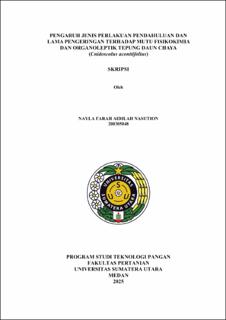| dc.description.abstract | Cnidoscolus aconitifolius, also known as chaya leaves, are rich in vitamins
and antioxidants. Chaya leaves are processed into flour to provide nutrients in food
products. Blanching, soaking in sodium metabisulfite, and soaking in calcium
hydroxide are examples of pretreatment methods used in order to maintain the
nutrients in chaya leaves while also producing flour with the best organoleptic
value. Effective drying time leads to flour that matches required standards. This
research was aimed to determine the effect of pretreatment type and drying time
and the interaction of both on the physicochemical and organoleptic qualities of
chaya leaves flour. This research used the factorial Completely Randomized Design
(CDR) method with two factors: pretreatment type (P) which includes (blanching,
soaking in sodium metabisulfite, and soaking in calcium hydroxide) and drying time
(L) at (4 hours, 5 hours, 6 hours, and 7 hours).
The results indicate that the pretreatment type (P) significantly affected
(P<0.01) the moisture content, ash content, protein content, carbohydrate content,
color index, antioxidant activity, flour yields, description of color, description of
aroma, hedonic color, hedonic aroma, and overall acceptance of chaya leaf
powder. Drying time also significantly affected (P<0.01) the moisture content, ash
content, fat content, protein content, carbohydrate content, crude fiber content,
color index, antioxidant activity, flour yields, description of color, description of
aroma, hedonic color, hedonic aroma, and overall acceptance of chaya leaf
powder. The best treatment was determined based on the De Garmo method was
P2L2, which were the treatment with a pretreatment type of soaking in sodium
metabisulfite and duration of drying time in 5 hours. | en_US |


